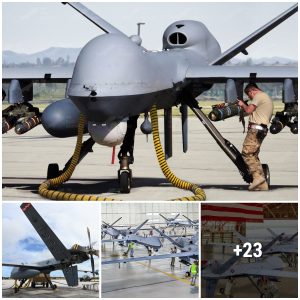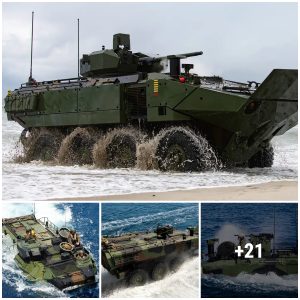Ukraine wants long-range weapons that can target Russian forces far behind enemy lines. It just might get them.
With its defenses already bolstered by shipments of weapons from NATO, Ukraine now has a new wishlist of weapons it hopes will prove decisive in the ongoing war with Russia. Kyiv has asked for long-range rocket artillery, attack drones, and anti-ship missiles to beat back the Russian invasion, and already at least one NATO ally, Denmark, has pledged to step up. The weapons are more necessary than ever as a fresh Russian offensive makes gains in the Ukrainian state of Luhansk.

Ukraine already fields all three of those weapon types, as Defense News points out, but U.S. and NATO-made versions would be both more technologically advanced and generally more capable. The weapons would serve alongside those already provided by NATO, including Javelin anti-tank missiles, NLAW anti-tank rockets, M777 howitzers, and Switchblade kamikaze drones.
M142 HIMARS Rocket Artillery System

The U.S.-made HIMARS is at the top of the list. The High Mobility Artillery Rocket System (HIMARS) is an armored five-ton truck equipped to launch 227-millimeter (8.93-inch diameter) rockets. Each HIMARS carries six GPS-enabled Guided Multiple Launch Rocket System (GMLRS) rockets. And, according to the U.S. Army, each conducts “high-volume destructive, suppressive, and counter-battery fires,” or artillery missions at ranges of up to 43 miles. HIMARS can “out-stick” most Russian artillery, firing on it from beyond the range of Russian guns and rocket launchers.
Ukraine already has a variety of rocket artillery systems, including the BM-30 Smerch 300-millimeter rocket system. Most rocket artillery systems are unguided, and rocket artillery is less accurate than tube (howitzer) artillery. Rocket artillery is therefore typically relegated to the suppression mission, with each rocket carrying smaller high-explosive or anti-tank cluster munitions. As the rocket flies over the target, the cluster munitions disperse, covering a wide area.
Here’s a video of U.S. forces using HIMARS in live-fire exercises:
HIMARS is different from other rocket systems. In recent years, outrage over the threat that unexploded submunitions pose to civilians led to a global treaty outlawing the weapons. Although the United States is not a party to the treaty, it no longer develops them and has shelved existing submunition ammo stocks. This has forced HIMARS to take a different path: instead of showering a wide area with thousands of tennis ball-sized bomblets, HIMARS makes each rocket count. Each GMLRS rocket is capable of first-round hits on a set of GPS coordinates, using a unitary, single large warhead designed to make up for the loss of hundreds of smaller submunition warheads.
It was unthinkable three months ago that Ukraine might receive HIMARS, but times are changing. So far, the Biden administration has not approved the request, but is reportedly considering it. Senate Minority Leader Mitch McConnell suggested he wouldn’t say no to a transfer, indicating there could be bipartisan support.
MQ-1 Gray Eagle Attack Drone

Ukraine also wants reusable attack drones. It already operates a small fleet of TB-2 Bayraktar attack drones, each capable of carrying smart micro munition (MAM-L) guided bombs. Although Bayraktars have proven effective in striking Russian supply convoys and armored vehicles, particularly behind enemy lines, it’s less capable than NATO-operated drones. Ukraine is also likely running low on Bayraktars, as combat losses mount.
Although the U.S. government has provided Switchblade 300 and 600 kamikaze drones, these are one-way weapons that are not designed to fly more than one mission. An obvious solution to Ukraine’s problem is the U.S. Army’s MQ-1C Gray Eagle. Gray Eagle is larger, faster, flies higher, and carries a bigger and better weapons payload than Bayraktar. Gray Eagle has much longer legs than Bayraktar, capable of flying up to 2,500 nautical miles versus 186 miles due to the use of satellite navigation.
Here’s a video of a Gray Eagle taking off from an unspecified country “in the Middle East region.” Note the two AGM-114 Hellfire missiles:
Gray Eagle, which acts as an uncrewed scouting platform for AH-64 Apache attack helicopters, would be a considerable upgrade from Bayraktar. Gray Eagle can carry up to four Hellfire anti-tank missiles, each with a range of up to 6.8 miles. By contrast, Bayraktar must fly much closer to the target to release its MAM-L bombs. This boost in range will allow Ukrainian drone operators to conduct standoff attacks, staying out of the range of all but dedicated air systems, and in general lasting longer over the battlefield.
Ukraine first asked for Gray Eagle drones in late April, and has held discussions with its manufacturer, General Atomics. The U.S. government may be hesitant to sign off on a transfer due to Russia’s past complaints that armed drones like the Predator, Reaper, and Gray Eagle are technically equivalent to cruise missiles, and this could open up Washington to allegations that it’s providing cruise missiles to Kyiv. Armed drone transfers are also strictly regulated under the Missile Technology Control Regime, an international agreement meant to prevent the proliferation of long-range missile technology, as Politico points out. The Trump administration loosened those rules, but the Biden administration may be hesitant to follow suit.
Harpoon Anti-Ship Missile

One of the most spectacular of Russia’s many failures in the war was the loss of the Moskva, a guided-missile cruiser and flagship of the Black Sea Fleet. Two Ukrainian-made Neptune missiles, fired from a truck based on shore, sunk the 600-foot-long warship. While that was the humiliating end of Moskva, it wasn’t the end of the Russian Navy, which continues to patrol Ukraine’s coastline and threaten amphibious landings behind the front line.
Neptune is a brand-new missile system that became operational pretty recently in late 2021. Ukraine has requested more anti-ship missiles from NATO that would allow it to take the offensive, sinking Russian warships blocking its ports—including critical grain shipments to countries worldwide—or pushing them far enough out to sea that they become irrelevant.





